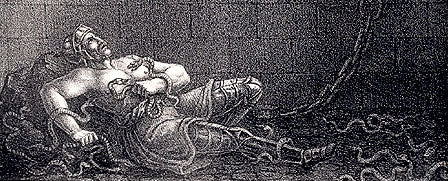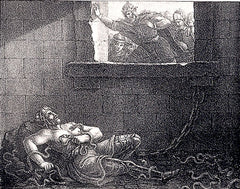on all orders over $100
on all orders over $100

Ragnar Lothbrok was a legendary viking leader who lead numerous raids against the British Isles and northern France. The tales of his extraordinary exploits were immortalised by Icelandic sagas from the 13th century and more recently popularised by the TV show 'Vikings'.
In addition to his own accomplishments Ragnar also fathered many prominent Vikings who went on to accomplish great feats in their own right. His sons; Halfdan Ragnarsson, Bjorn Ironside, Ivar the Boneless, Sigurd snake-in-the-eye, Hvitserk and Ubba, went on to lead the great heathen army into England, which would change the course of British history forever.
Much like his character in the TV show Ragnar was rather fond of women, and in the sagas he is said to have had no less than three wives. Thora was his first wife, followed by Aslaug and Lagertha. In a 13th century source known as the 'Gesta Danorum' there is also mention of a fourth wife named Swanloga.

15th century drawing of Ragnar and his sons, Ivar and Ubba
In some of the later sources such as the 'tale of Ragnar's sons' Ragnar was said to have been the son of a Viking kind named Hring, who ruled over lands in modern day Sweden and Denmark and passed on his title to Ragnar once he died.
His name 'Ragnar Lothbrok' is an anglicised version of the Old Norse name 'Ragnarr Loðbrók' which is translated directly into modern English would mean something similar to 'Ragnar shaggy breeches'. As was common in Scandinavian culture many of his children took the surname 'Ragnarsson' which meant 'son of Ragnar'.
In the Gesta Danorum, written by the famous Danish historian Saxo Grammaticus, Ragnar was portrayed as a powerful Danish King who lead numerous invasions into foreign lands, including a battle against the famous holy roman emperor, Charlemagne.
There were also numerous Frankish sources which described the Viking attack on Paris during the year 845 AD which mention a Viking leader with a name similar to Ragnar who is often thought to be Ragnar Lothbrok. There are also numerous accounts of the exploits of Ragnar's sons from sources in the UK and Ireland, along with later Icelandic sources which are the most detailed, however likely lack historical accuracy since they were written much later.
This is one of the most comprehensive and detailed accounts of Ragnar's life, however since it was written in Iceland around 300 years after his death there are certain doubts about its historical accuracy.
The story begun with Aslaug, who was said to be the daughter of Sigurd and the famous valkyrie Brunhilde. She grew up in Norway whilst Ragnar who was the son of the Danish king was becoming a skilled warrior and already gaining notoriety for his martial talents.
In his first quest Ragnar travelled to the Swedish island of Jotlund (now known as Gotland) where he helped a local Jarl slay a dragon which had been causing his people problems. This is allegedly where Ragnar acquired the name 'Lothbrok' as he used shaggy trousers and a cloak which had been boiled in tar to protect him from the dragons fire while he slew the beast with his spear.
As a reward for this act of bravery the Jarl granted Ragnar his daughters hand in marriage, this is how Ragnar met his first wife, Thora, with whom we would have two children. They were happily married for a time, however before long Thora fell ill and died suddenly. Ragnar was greatly saddened by this and to receive him of his grief he decided to travel to Norway.

Ragnar and Aslaug - August Malmström
On his travels Ragnar encountered Aslaug and was be-stricken by her beauty. He was so taken with her that he decided to marry her, however he wished to test her intellect first to see if she was worthy. He gave her a riddle to solve, which Aslaug completed easily. The two of them married and had three children, including Ivar the boneless who was born with a medical condition, allegedly due to the fact that Aslaug had warned Ragnar to wait three days before consummating their marriage, however since he did not the child was cursed and born with this affliction. Aslaug also predicted that one of their children would be born with a 'snake in his eye' and so their son, Sigurd, was named Sigurd snake-in-the-eye, presumably due to some physical defect in his pupil.
The saga continued with various battles against a Swedish king where both Ragnar and Aslaug lead their sons into battle and were met with various degrees of success. This dispute with the king arose from the fact that Ragnar turned down his daughters hand in marriage in order to marry Aslaug instead.

Ragnar's execution at the hands of kind Aella - 19th Century artists impression
Once the war with the Swedish king had been won Ragnar was drunk with success and decided that he would invade Britain with only two ships, which unfortunately for him didn't turn out very well. Ragnar's raid was ultimately unsuccessful and he was captured by king Aella of Northumbria and put to death by being thrown into a pit of venomous snakes.
The final part of the saga tells of Ragnar's sons invading Northumbria at the head of the great heathen army and defeating Aella in battle before killing him in the brutal and infamous 'blood eagle' execution.
A follow up to the saga of Ragnar was the 'tale of Ragnar's sons' which was written around 100 years after. This was a saga detailing the exploits of Ragnar and his sons actions to avenge his death, and was considered to be an improvement upon the earlier work.
There were various differences between the two versions, however most of them were minor variations. The major differences in the stories include the later works painting a picture of a larger Viking empire including lands in both Denmark and Sweden which Ragnar inherited from his father king Hring, and his sons controlling an even larger group of territories adding Norway, large parts of the British Isles, northern Germany and various baltic regions to their dominion.
The tale of Ragnar's sons portrayed Ragnar as a just and worthy ruler and went into much more detail than the earlier works about the exploits of his sons prior to his death. Ragnar was said to be a descendant of the Danish and Norwegian line of kings, however surprisingly for an Icelandic source their own lineage was left out of the story.
There is some dispute about the historical accuracy of the stories about Ragnar's life, and debate as to whether or not he even existed at all. It is likely that many of the tales have become partly legendary and been expanded on over time.
It is a generally accepted theory that most of the stories of Ragnar's sons, Bjorn, Ivar, Sigurd, Ubbe, etc. were based on the actions of real historical characters. Sceptics often site the fact that many of the sources of Ragnar's life were written hundred years after, so their accuracy is dubious at best. In addition to this the tales from Saxo Gramatticus' Gesta Danorum seemed to be an agglomeration of various stories from different historical figures consolidated into the convenient story of one legendary king.
Ultimately it is not known how accurate the stories of Ragnar's life are and we will probably never know, however it seems likely that there is some historical truth upon which the legendary character was based.
If you enjoyed our article or have anything to add then please leave a comment below.
Check out our handmade Ragnar Axe.
Leave a comment